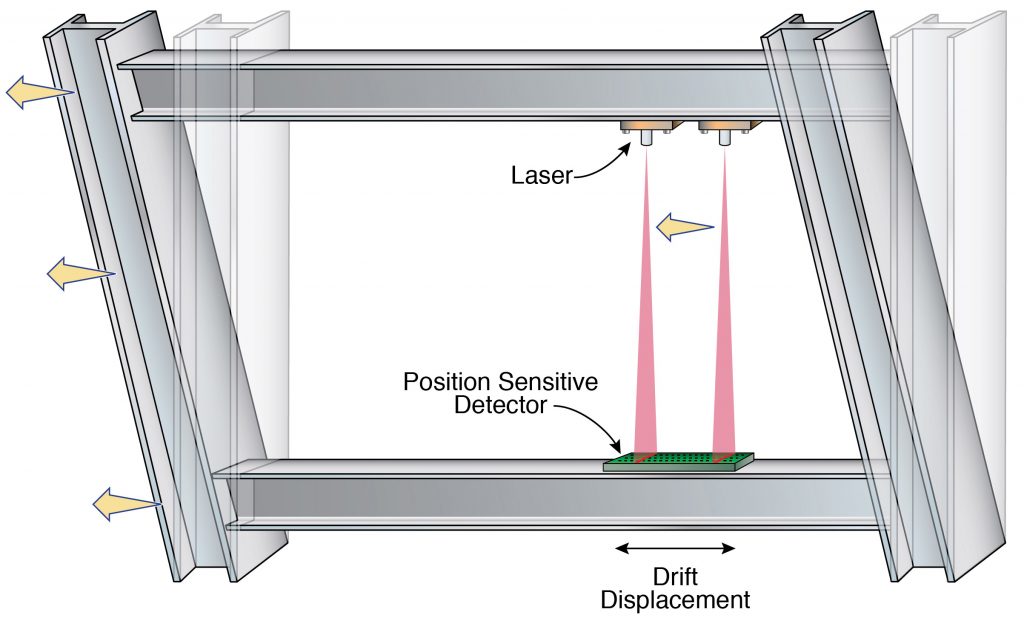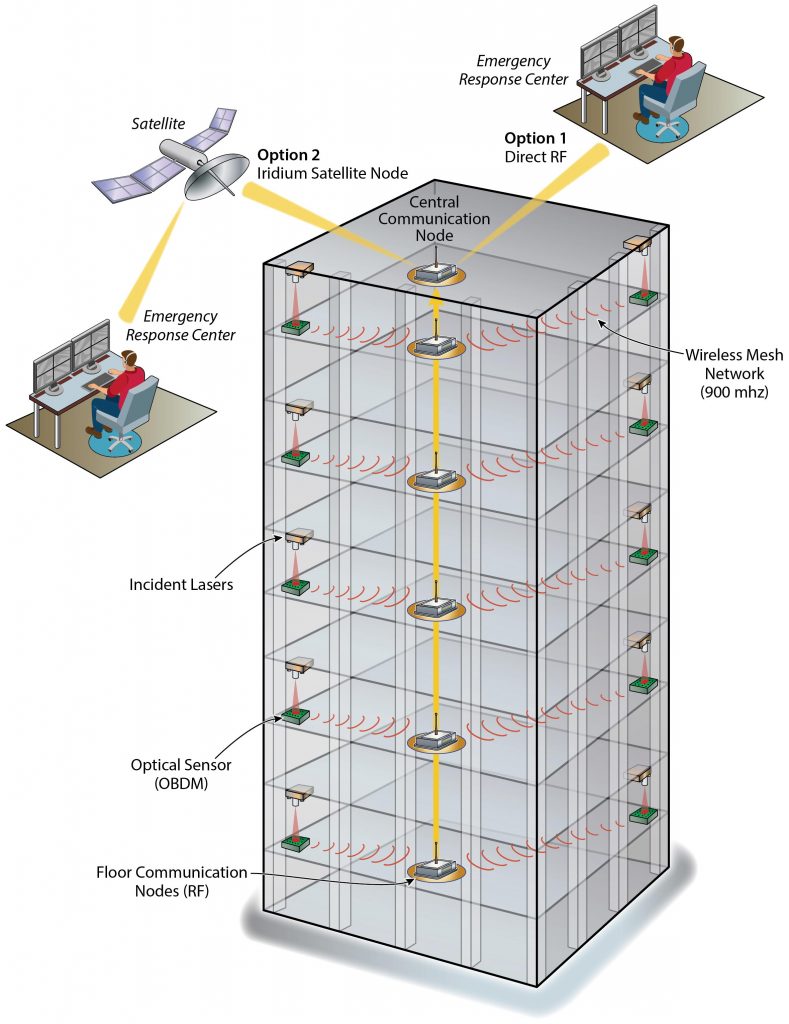By Alka Tripathy-Lang, Ph.D. (@DrAlkaTrip)
Engineers may have found a way to measure displacement between floors of multistory buildings cheaply, accurately and in real-time, paving the way for quick analysis of the stability of critical infrastructure (e.g. hospitals, airports, water treatment plants) in the event of an earthquake.
Citation: Alka Tripathy-Lang (2019), Lasers speed up seismic damage assessments, Temblor, http://doi.org/10.32858/temblor.040
The Mw 7.1 earthquake on July 5, 2019, was the largest quake California has seen in 20 years. Part of the so-called Ridgecrest earthquake sequence, the Mw 7.1 event served as a reminder of the seismic hazard associated with living on the West Coast of the United States. Although these tremors struck a relatively sparsely populated region, significant damage was sustained, with the estimated economic impact in excess of $100 million. Determining the extent of damage to individual buildings is an arduous and time-consuming task. Now, engineers are testing a state-of-the-art laser-based system that could dramatically speed up post-earthquake damage assessments by accurately measuring displacement between floors of multistory buildings.

Is the building safe?
In the chaos immediately following a large, damaging earthquake, structural engineers have a massive workload in assessing the safety of affected buildings, especially critical infrastructure like hospitals and water treatment plants, and large buildings like multistory apartment or office buildings. “The post-event environment is overwhelming and confusing, and people need to know right away if they can go back to work or go home,” says Floriana Petrone, an assistant professor of structural engineering at the University of Nevada, Reno (UNR), visiting faculty scientist at the U.S. Department of Energy Lawrence Berkeley National Laboratory (LBNL), and lead author of a paper published in Engineering Structures that presents results from tests of the new laser-based system.
Structural engineers typically spend a day or two evaluating buildings that are under contract, says Ronald Hamburger, a senior principal at Simpson, Gumpertz & Heger, a company that designs, investigates and rehabilitates buildings and structures. Then the engineers respond to calls from other building owners wanting to determine if their buildings are safe for reentry immediately or if they need repairs first, in which case, the engineers develop repair plans. In a few cases, Hamburger says, the damage is obvious. But many buildings conceal their wounds within the walls, he says. This is particularly problematic for certain steel-framed buildings, where the only method to assess damage extent is to manually remove asbestos-based fireproofing. This potentially dangerous damage assessment process can take days to weeks.
Petrone and her UNR/LBNL colleague David McCallen, who first envisioned the technology, think their system could dramatically speed up post-event evaluation of building safety — allowing such evaluations to be completed in minutes instead of days.
Lasers, sensors, wifi and an app
The idea, Petrone says, starts with deploying light-sensitive optical sensors to each story of a multistory building. “All you need,” she says, “is a clear line of sight between the floor and ceiling.” Then, lasers are mounted to the ceiling that shine down onto optical sensors installed on the floor. By determining which sensors are in contact with the laser line at a given time, the location of the laser source can be precisely determined. If the laser moves during an earthquake, then the sensors turn on and off, which informs researchers how much the laser — and by inference, the point at which the laser has been mounted — has moved relative to the location of the sensors. This is the “drift displacement.” Engineers then measure “interstory drift,” which is the movement of each story relative to one another. The interstory drift shows structural deformation, and if the deformation is severe enough to be considered unsafe, as per codes and standards, the system would then inform occupants via a smartphone app that they need to evacuate.

The eventual goal, Petrone says, is to outfit buildings with these sensors, complete with backup battery, full wireless connectivity, backup satellite connection and a smartphone app. Not only would this system help residents by letting them know if their floors are damaged, she says, ideally it would also help structural engineers pinpoint which floors require remediation efforts and potentially prioritize their tasks.
A dramatic improvement
Current technology to monitor shaking-related deformation of a building works similarly to how a smartphone’s accelerometer rotates the screen depending on the phone’s orientation. For buildings, accelerometers are placed at different elevations to provide information on how the building is moving (acceleration). However, Petrone says, displacement is required to quantify structural damage, not acceleration, and the calculation of displacement from acceleration is incredibly challenging and cannot be done in real-time.
The new laser-based system measures the relative displacement between two adjacent stories while a building is moving and communicates this information in real-time. Additionally, Petrone says, “the accuracy of the latest generation of optical sensors is less than a millimeter, so we can see even small displacements from daily or weekly tremors [on active faults].”

First responders — a more targeted response
In the event of an earthquake, first responders will know which areas shook most severely from ground-shaking measurements and alerts received from agencies like the U.S. Geological Survey. But they don’t know which parts of a building are safe and which are not immediately after an earthquake unless the damage is obvious; the new technology could thus help first responders prioritize evacuations, which could be especially useful for skyscrapers. The technology would also provide an extra layer of safety for the first responders themselves, as they would have more information about areas to avoid within a building.
A cost-benefit analysis
Because building owners and occupants would bear the cost of installing and maintaining these sensors, the benefits must outweigh the cost. Although Petrone and her colleagues only have a pilot project so far, Petrone estimates that the final cost to consumers will be comparable with the cost of an accelerometer system, but with marked improvements that translate into dollars. Because displacement cannot be calculated in real-time from accelerometers, and the fact that accelerometers do not provide information on residual drift (permanent deformation sustained by all or part of a building), Hamburger estimates that only about 10 buildings in San Francisco have such technology installed. This lack of uniform implementation highlights the need for a new and more efficient system.
Knowing the displacement difference between stories of a multilevel building would expedite efforts to assess, fix and use buildings after an earthquake. Thus, Hamburger says, “this technology could potentially save owners of high-rise buildings hundreds of thousands of dollars in post-earthquake inspection costs.”
And if it turns out a building needs substantial repair, or to be razed, there may be faster turnaround when it comes to insurance payouts. Amar Rahman, principal risk engineer at Zurich Insurance Group, says that because loss adjustors would have more accurate damage assessments, the new technology could help expedite loss adjustment investigations. Major urban earthquakes, he says, are incredibly time consuming for manual investigations, so the speedier the damage assessments, the sooner any potential payouts could begin.
Rahman also points out that interstory drift may be an indicator of nonstructural damage — broken building infrastructure hidden behind walls and in ceilings, such as cracked water pipes and faulty electric systems — that is often impossible to assess and may only show up after a couple of weeks. Finding and repairing these issues immediately will keep them from becoming even bigger problems down the road.
Combined, all of these efficiencies could make the laser-based sensor system well worth the cost.
Critical infrastructure — a higher standard
Anything to improve safety is worth investigating, says Mitch Saruwatari, director of emergency management for Kaiser Permanente, a non-for-profit healthcare provider. That’s especially true for critical infrastructure, such as hospitals, police and fire departments, airports, mass transit systems and water treatment plants. Many of these sectors are already held to a much higher standard regarding design and construction, but if this technology could guide inspection teams directly to the locus of structural displacement on specific floors after a quake, it could decrease hospital downtime, Saruwatari says.
Testing the system
Petrone and her colleagues have tested their laser-based sensor system in a laboratory with the help of a shake table, a scaled three-story building frame, and a suite of instruments that provide cross-checks on the laser system results. They found no unanticipated impacts of shaking on the sensors themselves, and the sensors remained functional even after being subjected to multiple earthquake simulations.
They also generated a fully calibrated 3D computer model of the frame and sensor system in conjunction with their experiments that allowed them to explore scenarios that are difficult and expensive to recreate in a controlled environment. The model also allowed them to optimize the installation configuration of the sensors to potentially reduce the number of sensors required, and therefore, the cost of the overall system.
Next steps
The next step for Petrone and her colleagues is a pilot deployment in a multistory building at LBNL, which sits atop the active Hayward Fault. They will deploy sensors in opposite corners of the building to look at building displacement, with the additional goal of fully calibrating the wireless connectivity to ensure real-time data communication. Aside from ensuring that the system remains functional during earthquakes, the wireless architecture must include security features that keep the sensors safe from cyber-attacks, which is important for wireless systems. Assuming this test is successful, Petrone says, “initial deployment should be right around the corner.”
References:
Petrone, F., McCallen, D., Buckle, I., and Wu, S., 2018, Direct measurement of building transient and residual drift using an optical sensor system. Engineering Structures, v. 176, Dec. 1, 2018, p. 118-126 https://doi.org/10.1016/j.engstruct.2018.08.087
